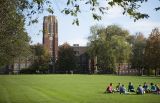Majority of American teenagers fail to meet the federal government's recommended physical activity levels, according to a data from the combined National Health and Nutrition Examination Survey (NHANES) and the National Youth Fitness Survey for 2012.
In 2012, only 24.8 percent of adolescents, aged 12 to 15 years old, were involved in the prescribed moderate- or vigorous-intensity aerobic physical activity for at least 60 minutes per day, according to Centers for Disease Control and Prevention (CDC). Nearly 8 percent of youth did not follow the guidelines at all.
"We can aim to do better than 25%," says the study's lead author, Tala H. Fakhouri, study's lead author and an epidemiologist with the National Center for Health Statistics (part of CDC), USA Today reports.
These findings are significant because previous studies showed that physical activity decreases with age. An earlier study conducted by Fakhouri and her colleagues found that 70 percent of children, aged 6 to 11, complied with the guidelines.
Michael Bergeron, executive director of the National Youth Sports Health & Safety Institute, said that there is a significant reduction in physical activity in children aged 6 to 15, because there are a lot of things going on in their lives - social distractions and academic pressure. Most of the time, they have to choose between playing sports, attending parties or preparing for exams.
But Fakhouri said that despite all their commitments, they still need to be physically active. Previous studies showed that regular exercise enhances physical health in children (increases their lean muscle mass and strengthens their bones), boosts self-esteem, promotes active learning and helps them to deal with stress.
"Regular physical activity among youth promotes physical and psychological health and improves some aspects of academic performance. Given that physical inactivity in adulthood is a modifiable risk factor for many diseases, such as cardiovascular disease and cancer, tracking the prevalence of physical activity among U.S. youth may help inform public health interventions," Fakhouri and researchers conclude in their report.
When looked at both the genders independently, 27.0 percent of boys and 22.5 percent of girls followed the guidelines, the recent study reveals. This is not a surprising find as previous studies have already proved the fact that boys are more physically active than girls.
Basketball was the most popular physical activity reported among active boys, when compared to running for girls.
© 2025 University Herald, All rights reserved. Do not reproduce without permission.








